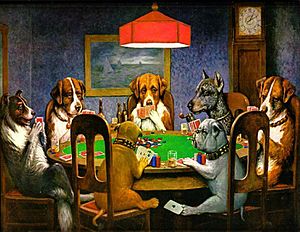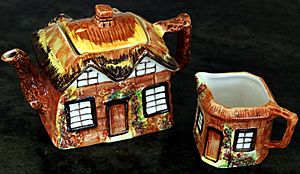Kitsch facts for kids

Kitsch (/kɪtʃ/ kitch; loanword from German) is a term applied to art and design that is perceived as naïve imitation, overly eccentric, gratuitous or of banal taste.
The modern avant garde traditionally opposed kitsch for its melodramatic tendencies, its superficial relationship with the human condition and its naturalistic standards of beauty. In the first half of the 20th century, kitsch was used in reference to mass-produced, pop-cultural products that lacked the conceptual depth of fine art. However, since the emergence of Pop Art in the 1950s, kitsch has taken on newfound highbrow appeal, often wielded in knowingly ironic, humorous or earnest manners.
To brand visual art as "kitsch" is often still pejorative, though not exclusively. Art deemed kitsch may be enjoyed in an entirely positive and sincere manner. For example, it carries the ability to be quaint or "quirky" without being offensive on the surface, as in the Dogs Playing Poker paintings.
Along with visual art, the quality of kitsch can be used to describe works of music, literature or any other creative medium. Kitsch relates to camp, as they both incorporate irony and extravagance.
History
As a descriptive term, kitsch originated in the art markets of Munich, Germany in the 1860s and the 1870s, describing cheap, popular, and marketable pictures and sketches. In Das Buch vom Kitsch (The Book of Kitsch), published in 1936, Hans Reimann defined it as a professional expression "born in a painter's studio".
The study of kitsch was done almost exclusively in German until the 1970s, with Walter Benjamin being an important scholar in the field.
Kitsch is regarded as a modern phenomenon, coinciding with social changes in recent centuries such as the Industrial Revolution, urbanization, mass production, modern materials and media such as plastics, radio and television, the rise of the middle class and public education—all of which have factored into a perception of oversaturation of art produced for the popular taste.
Uses
Art
The Kitsch movement is an international movement of classical painters, founded in 1998 upon a philosophy proposed by Odd Nerdrum, which he clarified in his 2001 book On Kitsch, in cooperation with Jan-Ove Tuv and others incorporating the techniques of the Old Masters with narrative, romanticism, and emotionally charged imagery.
See also
 In Spanish: Kitsch para niños
In Spanish: Kitsch para niños
- Camp
- Thomas Kinkade - Another American painter whose works are described as kitsch.
- Chocolate box art
- Cliché
- Lowbrow (art movement)
- Museum of Bad Art
- Poshlost
- Prolefeed
- Notable examples
- Velvet Elvis
- Chinese Girl
- Christmas cards
- His Master's Voice




